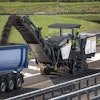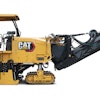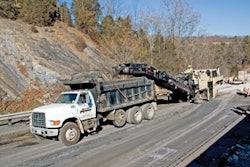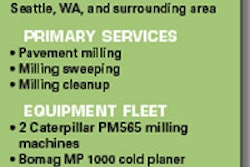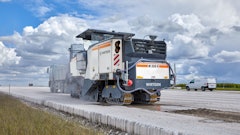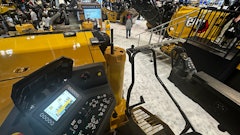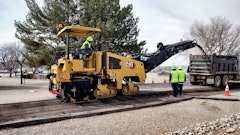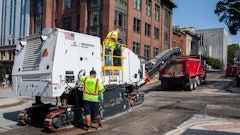By Sam Simon
Editor, ForConstructionPros.com
A milling machine or planer attachment can be an ideal money maker and time saver. However, to get the most out of your investment, you need to keep the unit up-and-running while operating at peak efficiency. It is important that you take the necessary steps to ensure this piece of equipment is properly maintained.
Cutting Teeth
The primary element of a milling machine or planer that is most susceptible to wear is the cutter-drum teeth. "Obviously those take the most abuse because they are in constant contact with the asphalt," explains Dynapac Product Manager Tom Chastain.
Jason Emlet, Technical Service Representative - Milling with Ingersoll Rand, says "The cutting drums are the heart of a milling machine. If these are not properly maintained the performance of the machine will suffer greatly. Not only will the production rate of the machine suffer, you will burn more fuel in the process."
Though it is inevitable that the teeth will wear, the rate at which they wear can be slowed. One way to extend the life of the teeth is to add water to the milling process. "Running a water system on the drum is going to prolong the life because the water acts as a coolant to the tools," says Chastain. In addition to cooling the teeth, the water becomes a lubricant between the teeth and asphalt. Bill Bethards, Manager of Sales and Product Support with Zanetis, says tooth life can be increased by 20 to 30 percent when using water on cold planer attachments. Water also has the added benefit of reducing the amount of dust that is created by using a planer or milling machine.
Teeth rotation also determines the life of the teeth. "If a tooth seizes up within the holder, you're only going to have wear one side," says Bethards. "It will look as though someone put a grinding wheel to the surface." The housing the tooth sits in should regularly be cleaned so the tooth is able to spin freely. Bethards recommends owners clean with a water-based, soapy release agent at the end of the day to help break down the emulsion.
It is important to keep your teeth fresh as they have one of the greatest impacts on how efficient your machine will run. "If the engine is in good shape, the belt is in good shape, but I've got bad teeth, my production is going to suffer," says Chastain. "Instead of stabbing a knife into something, you're hitting it with blunt trauma similar to a flat-faced stick."
Daily Maintenance
When the operator is finished working with the milling machine for the day and all the material is out of the machine, he should pull the machine off to the side of the road to perform daily maintenance checks. "Get the belts turning and make sure there is no excess material in there," says Chastain.
The next step is to give the machine a high-pressure wash. Chastain points out that it is important to clean the drum, within the tracks, the conveyors to as far as the rollers and the build-up on the side of the conveyors. In addition to these parts, the radiator is another part of the machine that should be washed. "It's not an every day thing, but you may want to do a quick wash of the radiator," says Chastain. "You're turning the broom behind you which could suck up a lot of dust and cause the machine to overheat."
Efficient Operation
"Selecting the right cutting tool for the cutting application is the most important to keeping the machine running efficiently," says Emlet. "Keeping good tools in the machine will keep the mill working at an efficient rate. Keeping good conveyor belts on the machine will also keep you running efficiently."
There are ways that will identify if your machine is not running efficiently and one or more maintenance items may need to be corrected to get it back to running at peak performance. Emlet says one indication is to look at the cut pattern left behind to tell how well the machine is performing and how much the engine seems to be laboring in relation to ground speed. "As the teeth wear out it will take more engine power to propel the machine at the same speed. Once you reach the point where the machine is slowing down you will need to weigh out the tooth cost vs. extra fuel cost to do the same amount of work as a new set of teeth," says Emlet.
General Tips
Even more advice from Bethards, Chastain and Emlet on how to keep your planer attachment/milling machine working at peak capacity.
Grease, add fuel, fill the machine with water and check the tooling at the end of the work day. If teeth need to be changed, do it that night. Make sure when you go to work the next morning you can just put in the key and begin working (after your morning walk-around checking oil levels, looking for leaks, etc.).
Track and conveyor belt tensioning should be correct. If you run the belts too loose you could have some premature failure as well as some excessive damage.
When connecting a planer attachment to a skid steer, make sure the case drain line gets hooked up. If this line is not hooked or becomes pinched, this restriction would cause drive motor damage.
DELETE: Do not engage teeth with a trailer ramp or the grinding surface if the hydraulics are off. If the drum spins there is no where for the oil to go. That can cause a blown shaft or other problem.
With a planer attachment, make sure there is enough down force. If it is hopping, it is not cutting. Run at the recommended speed for the depth, material age and aggregate size.
Check filters once a week. Twice a week if performing large amounts of milling.
Conveyor belts are also crucial to the performance of a milling unit. Worn out belts will not efficiently carry away milled material from the drum causing premature wear to the teeth and drum components.

